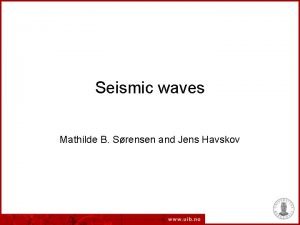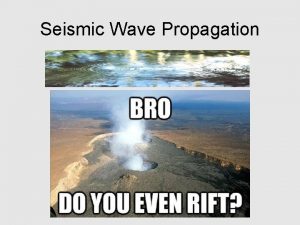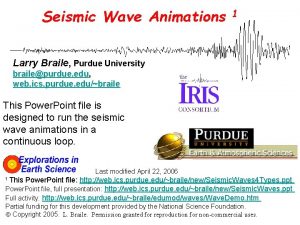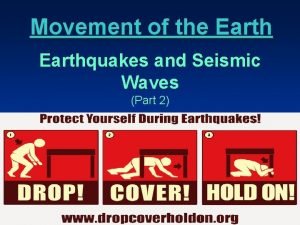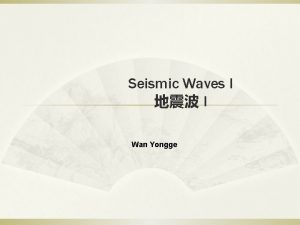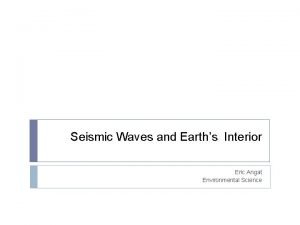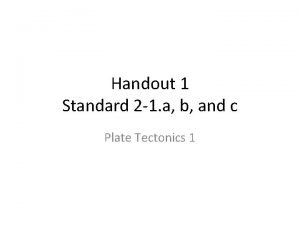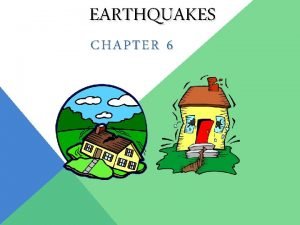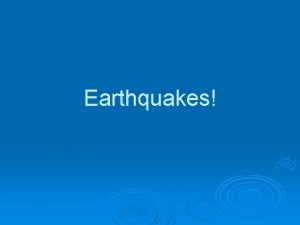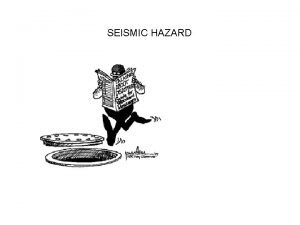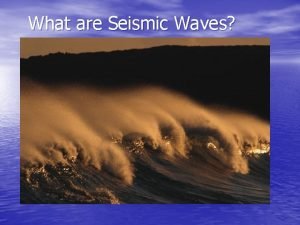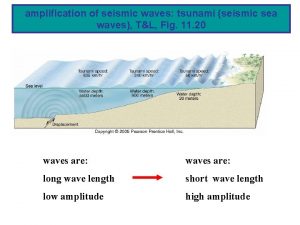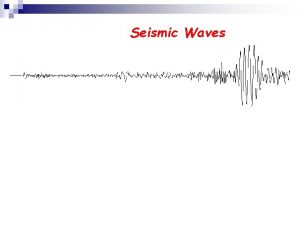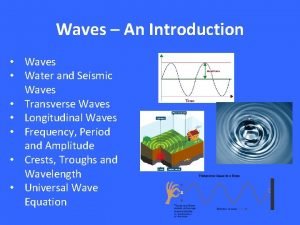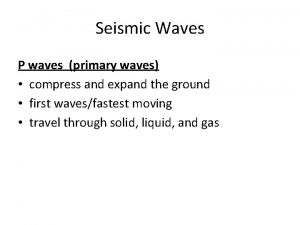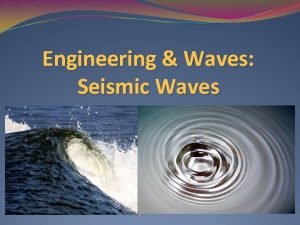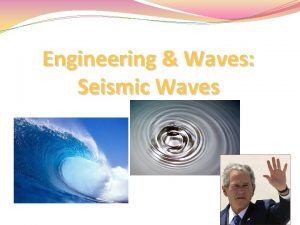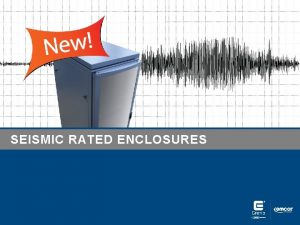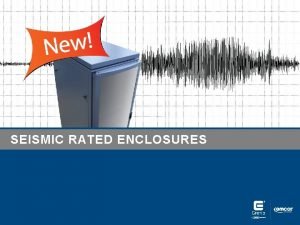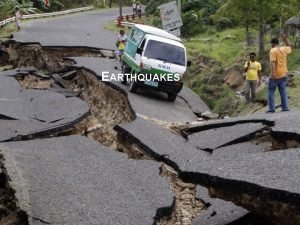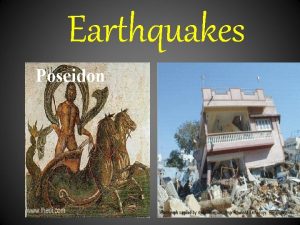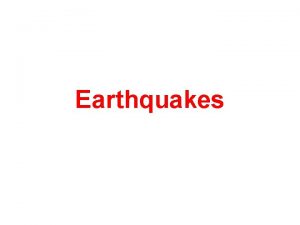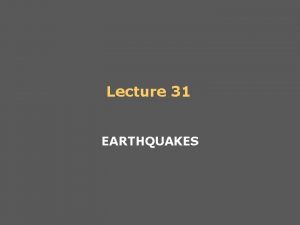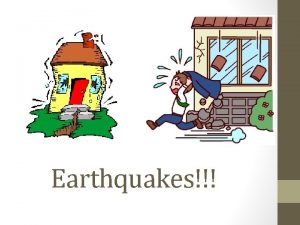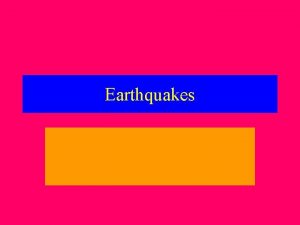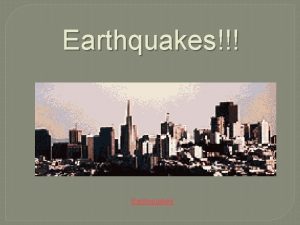Movement of the Earthquakes and Seismic Waves Part


























- Slides: 26

Movement of the Earthquakes and Seismic Waves (Part 2)

-Turn to the beginning of Chapter 14 Section 2 which starts on page 467. -Take a few minutes to flip through sections 2 & 3 looking at the diagrams and reading the caption that accompanies each.

Writing in Science: News Report (pg. 473) – Is to be completed independently – Should be at least 1 paragraph (NO LESS THAN 8 SENTENCES) – Will be graded for spelling, grammar and content – Will be counted as a QUIZ GRADE – Due on FRIDAY, APRIL 8 th

Earthquakes and Seismic Waves • Every day, worldwide there are several thousand earthquakes. • An earthquake is the shaking and trembling that results from the movement of rock beneath Earth’s surface.

Earthquakes and Seismic Waves • Plate movements cause stress in Earth’s crust, adding energy to the rocks and forming faults. • Stress increases along the fault until the rock breaks, causing an earthquake. • In seconds the earthquake releases an enormous amount of stored energy.

Earthquakes and Seismic Waves • Most earthquakes begin in the lithosphere within about 100 km of Earth’s surface. • The focus is the area beneath Earth’s surface where the rock that is under stress breaks, triggering an earthquake.

Earthquakes and Seismic Waves • The point on the surface directly above the focus is called the epicenter. • During an earthquake, the most violent shaking is found at the epicenter because seismic waves reach the epicenter first.

Types of Seismic Waves • During an earthquake, seismic waves race out from the focus in all directions. • Seismic waves carry energy from an earthquake away from the focus, through Earth's interior, and across the surface.

Types of Seismic Waves • There are three main categories of earthquake waves: primary waves (P waves), secondary waves (S waves), and surface waves. • P waves and S waves originate from the earthquake's focus. • When these waves reach the epicenter, surface waves develop.

Types of Seismic Waves Primary Waves: • The first waves to arrive are primary waves, or P waves, and are generally felt as a jolt or thump. • P waves are seismic longitudinal waves (like a slinky) that compress and expand the ground like an accordion.

Types of Seismic Waves Secondary (Shear) Waves: • Secondary waves, or S waves, are slower and stronger than P waves and arrive after P waves. • S waves are seismic transverse waves that vibrate from side to side as well as up and down, shaking the ground back and forth. • Unlike P waves that can move through both solids and liquids, S waves cannot move through liquids.

Types of Seismic Waves Surface Waves: • When P waves and S waves reach the surface, some of them become surface waves. • Surface waves move more slowly than P and S waves, but can produce more severe ground movements. • Some surface waves make the ground roll like ocean waves. Others shake buildings from side to side.


Measuring Earthquakes • Three commonly used methods for measuring earthquakes are the Mercalli scale, the Richter scale, and the moment magnitude scale.

Measuring Earthquakes: The Mercalli Scale • The Mercalli scale was developed to rate earthquakes according to the level of damage at a given place. • The Mercalli scale uses roman numerals to rank earthquakes by how much damage they cause.

Measuring Earthquakes: The Richter Scale • An earthquake’s magnitude is a number that geologists assign to an earthquake based on the earthquake’s size. • Magnitude is measured by measuring the seismic waves and fault movement that occur during an earthquake.

Measuring Earthquakes: The Richter Scale • The Richter scale is a rating of an earthquake’s magnitude based on the size of the earthquake’s seismic waves. • The seismic waves are measured by a seismograph, which is a machine that records and measures earthquake waves. • The Richter scale provides accurate measurements for nearby earthquakes, but does not work well for large or distant quakes.

Measuring Earthquakes: The Moment Magnitude Scale • Geologists today use the moment magnitude scale, a rating system that estimates the total energy released by an earthquake. • This scale can be used to rate earthquakes of all sizes near or far. • You may hear news reports that mention the Richter scale, but the number quoted is almost always the moment magnitude of the quake.

Measuring Earthquakes: The Moment Magnitude Scale • To rate an earthquake using the moment magnitude scale, the geologists first study data from seismographs. • The data show what kind of seismic waves were produced and how strong they were. • The data also help geologists infer how much movement occurred along the fault and the strength of the rocks that broke when the fault slipped. • Geologists use all this information to rate the quake on the moment magnitude scale.

Measuring Earthquakes: Comparing Magnitudes • An earthquake’s magnitude tells geologists how much energy was released by the earthquake. • Each one-point increase in magnitude represents the release of roughly 32 times more energy. • For example, a magnitude 6 earthquake releases 32 times as much energy as a magnitude 5 and about 1, 000 times as much as a magnitude 4 quake.

Fill in the table. Use the 1 st paragraph on page 472 to help you. MAGNITUDE QUAKE DESCRIPTION Below 3 People scarcely notice Below 5 Small and cause little damage Between 5 & 6 Can cause moderate damage Above 6 Can cause great damage 8 or above Most powerful, are rare Above 9 Chile in 1960 and Alaska in 1964

3. 0 Magnitude

5. 0 Magnitude

8. 0 Magnitude

Locating the Epicenter • Geologists use seismic waves to locate an earthquake’s epicenter. • Seismic waves travel at different speeds. • P waves arrive at a seismograph first with S waves following close behind. • The farther away an earthquake is from the epicenter, the greater the time between the arrival of the P waves and the S waves.

Locating the Epicenter: Triangulation • Geologists draw at least three circles using data from different seismographs all over the world. • The center of each circle is the particular seismograph’s location. • The radius of each circle is the distance from that seismograph to the epicenter. • Where three circle intersect is the location of the epicenter.
 Seismic waves are mechanical waves
Seismic waves are mechanical waves Compare and contrast p waves and s waves using venn diagram
Compare and contrast p waves and s waves using venn diagram Seismic
Seismic What are wavefronts
What are wavefronts Seismic waves
Seismic waves Seismic waves animation
Seismic waves animation Seismic wave types
Seismic wave types Surface waves and body waves
Surface waves and body waves Wave velocity equation
Wave velocity equation Which type of wave can penetrate the outer and inner core?
Which type of wave can penetrate the outer and inner core? Seismic waves
Seismic waves Seismic waves
Seismic waves Four types of seismic waves
Four types of seismic waves What are the factors of earthquake
What are the factors of earthquake Difference between mechanical and electromagnetic waves
Difference between mechanical and electromagnetic waves Mechanical and electromagnetic waves
Mechanical and electromagnetic waves Mechanical and electromagnetic waves similarities
Mechanical and electromagnetic waves similarities Short wave vs long wave radiation
Short wave vs long wave radiation Mechanical waves and electromagnetic waves similarities
Mechanical waves and electromagnetic waves similarities Mechanical waves and electromagnetic waves similarities
Mechanical waves and electromagnetic waves similarities Mechanical waves and electromagnetic waves venn diagram
Mechanical waves and electromagnetic waves venn diagram Aimtoknow
Aimtoknow Sound is a transverse wave true or false
Sound is a transverse wave true or false The wave chapter 13
The wave chapter 13 Sound waves longitudinal waves
Sound waves longitudinal waves Examples of mechanical and electromagnetic waves
Examples of mechanical and electromagnetic waves Chapter 8 section 2 earthquake measurement answer key
Chapter 8 section 2 earthquake measurement answer key


